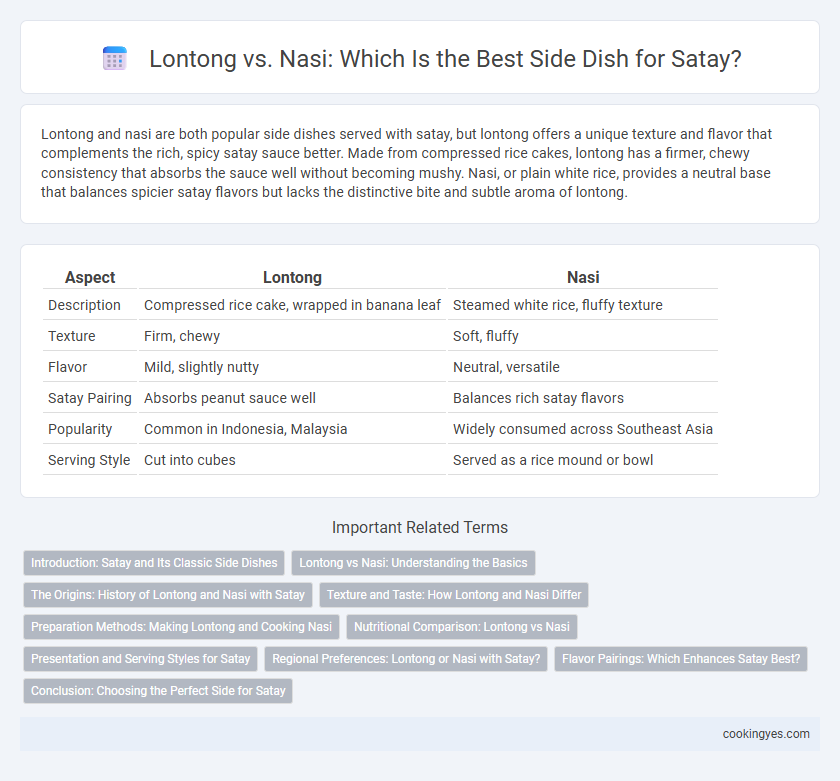Lontong and nasi are both popular side dishes served with satay, but lontong offers a unique texture and flavor that complements the rich, spicy satay sauce better. Made from compressed rice cakes, lontong has a firmer, chewy consistency that absorbs the sauce well without becoming mushy. Nasi, or plain white rice, provides a neutral base that balances spicier satay flavors but lacks the distinctive bite and subtle aroma of lontong.
Table of Comparison
| Aspect | Lontong | Nasi |
|---|---|---|
| Description | Compressed rice cake, wrapped in banana leaf | Steamed white rice, fluffy texture |
| Texture | Firm, chewy | Soft, fluffy |
| Flavor | Mild, slightly nutty | Neutral, versatile |
| Satay Pairing | Absorbs peanut sauce well | Balances rich satay flavors |
| Popularity | Common in Indonesia, Malaysia | Widely consumed across Southeast Asia |
| Serving Style | Cut into cubes | Served as a rice mound or bowl |
Introduction: Satay and Its Classic Side Dishes
Satay, a popular Southeast Asian grilled meat dish, is traditionally served with either lontong or nasi as its classic side dishes. Lontong, compressed rice cakes, offers a chewy texture that contrasts with the tender meat, while nasi, steamed rice, provides a softer, fluffier base that absorbs the rich satay sauce. Both accompaniments enhance the overall flavor experience, highlighting regional preferences and culinary traditions.
Lontong vs Nasi: Understanding the Basics
Lontong and nasi are staple side dishes commonly served with satay, each offering distinct textures and flavors that complement the grilled meat. Lontong is compressed rice cake, steamed and cut into cubes, providing a firm and slightly chewy texture that soaks up satay sauce well. Nasi, or steamed rice, features fluffy grains that balance the rich, spicy satay marinade, making it a versatile accompaniment in satay dishes.
The Origins: History of Lontong and Nasi with Satay
Lontong, a traditional Indonesian compressed rice cake, originated as an easy-to-prepare, portable staple for Southeast Asian communities, often paired with satay to balance the rich, spicy flavors with its mild texture. Nasi, meaning cooked rice in many Malay languages, has been the foundational side in satay dishes across Malaysia and Indonesia due to rice's historic role as a dietary essential. Both lontong and nasi reflect regional agricultural practices and cultural preferences, shaping the way satay is enjoyed in different areas.
Texture and Taste: How Lontong and Nasi Differ
Lontong offers a firm yet chewy texture that absorbs satay's rich, spicy peanut sauce, creating a balanced flavor combination, while nasi (rice) provides a softer, fluffier base that complements the satay without overpowering it. The compressed rice cake of lontong delivers a subtle, slightly tangy taste from the boiling process in banana leaves, enhancing the overall dish complexity. In contrast, plain steamed nasi maintains a neutral flavor profile, allowing the savory and smoky satay flavors to remain the dominant taste experience.
Preparation Methods: Making Lontong and Cooking Nasi
Lontong is made by tightly packing rice into banana leaves and boiling it for several hours until it becomes a dense, compact rice cake with a firm texture, ideal for soaking up satay sauce. Nasi, or plain steamed rice, involves rinsing rice grains and then steaming or boiling them until fluffy, offering a lighter, more absorbent base for satay. The preparation method affects the texture and sauce absorption, with lontong providing a chewier bite and nasi delivering a softer complement to satay skewers.
Nutritional Comparison: Lontong vs Nasi
Lontong, made from compressed rice cakes, offers a lower glycemic index compared to nasi (steamed rice), making it a better option for blood sugar control when served with satay. Nutritionally, lontong contains fewer calories and less carbohydrate per serving than nasi, contributing to a lighter meal option. Both lontong and nasi provide essential carbohydrates, but lontong's firmer texture and reduced portion size favor calorie-conscious and diabetic-friendly diets alongside satay.
Presentation and Serving Styles for Satay
Lontong offers a compact, cylindrical presentation that complements satay by providing a neat, uniform bite, often wrapped in banana leaves for an authentic visual appeal. Nasi, typically served as loose steamed rice, creates a more casual and abundant side dish that absorbs the satay's spicy peanut sauce effectively. Both enhance the satay experience differently, with lontong emphasizing elegance in plating and nasi highlighting comfort and generosity in serving.
Regional Preferences: Lontong or Nasi with Satay?
In Indonesia, especially in Java and Sumatra, lontong--a compressed rice cake--is the favored side dish for satay, providing a firm texture that soaks up the rich peanut sauce effectively. In contrast, in Bali and parts of Malaysia, nasi (steamed rice) is commonly paired with satay, offering a lighter, fluffier complement that balances the grilled meat's intense flavors. Regional culinary traditions deeply influence whether lontong or nasi accompanies satay, reflecting local tastes and ingredient availability.
Flavor Pairings: Which Enhances Satay Best?
Lontong's soft, compressed rice cake texture absorbs satay's rich peanut sauce, creating a harmonious blend that balances savory and mildly sweet flavors. Nasi, or steamed rice, offers a neutral, fluffy base that highlights satay's smoky char without overpowering its robust marinade. For flavor pairings, lontong enhances satay by adding a subtle creaminess that elevates the sauce, while nasi provides a clean palate that emphasizes the meat's grilled essence.
Conclusion: Choosing the Perfect Side for Satay
Lontong, a compressed rice cake, offers a firm texture that soaks up satay's rich peanut sauce, making it an ideal complement. Nasi, or steamed rice, provides a lighter, fluffier base that balances the intense flavors without overpowering the dish. Selecting between lontong and nasi depends on whether you prefer a denser, sauce-absorbing side or a neutral, airy accompaniment to highlight the satay's taste.
Lontong vs Nasi for Satay side dish Infographic

 cookingyes.com
cookingyes.com